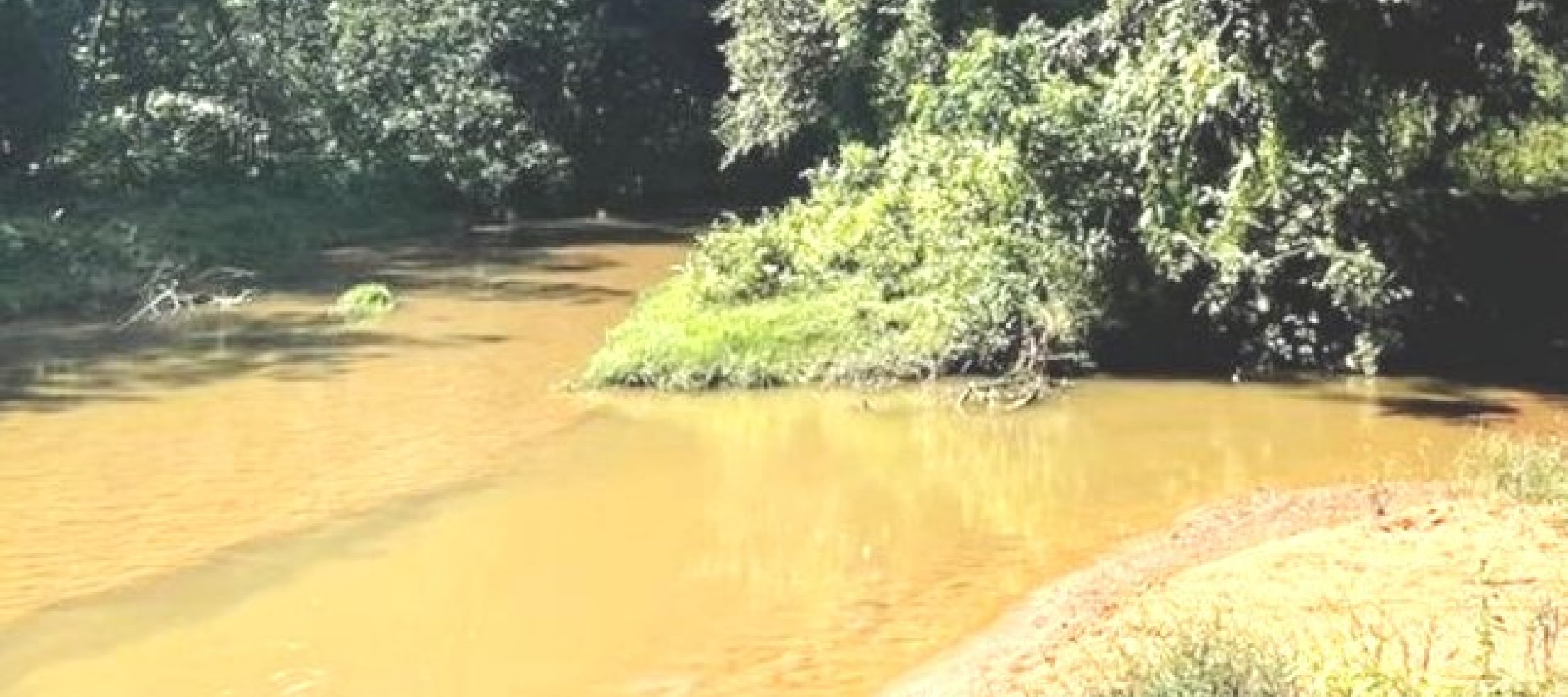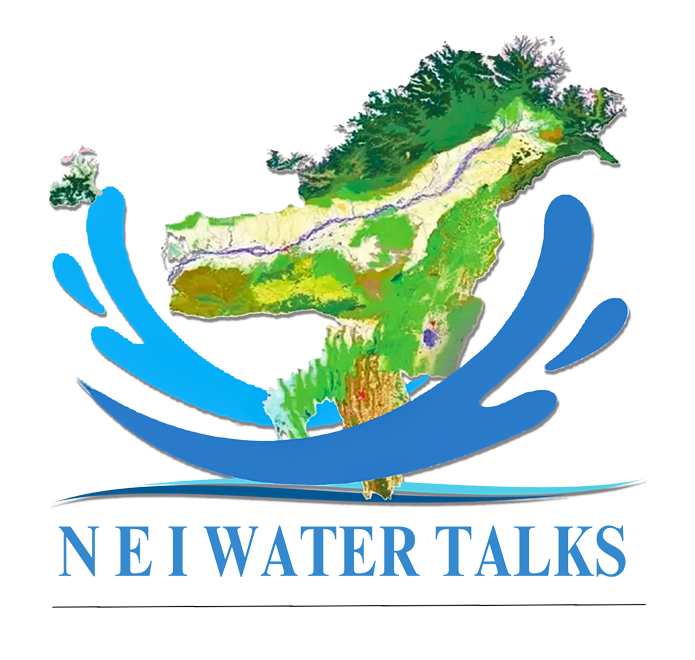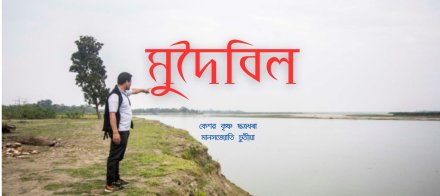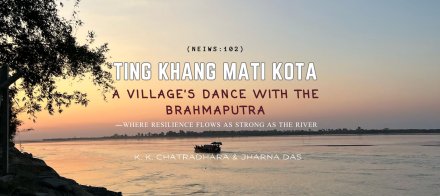 |
Introduction: The journey of a river through its entire course is always a gift to mankind. From the distant past, civilizations came into existence on the banks of great rivers where diverse flora and fauna existed. The people have an inalienable connection with the rivers from the evolution of mankind. If we dive deep into the development of cities, cultures and livelihood patterns; rivers play a most crucial role in all geographical areas.
The Sanskrit term ‘Tirtha’ which now means a place of pilgrimage was originally the Sanskrit term for a river ford or place of crossing. The Vedic text like ‘Rig Veda’ and later Vedic texts mentions about the importance of rivers and also the decline of the purest and sacred Saraswati River [Nadustuti hymn, Rig Veda]. The bard of Brahmaputra Dr. Bhupen Hazarika in his song “Mahabahu Brahmaputra” depicted Brahmaputra as a place of confluence of different cultures and their enlightened civilization. The word “Tirtha” finds a mention in his song.
Assam is a riverine state and the Assamese people have a very close relationship with rivers and streams. The evidence of cultural integration with aquatic bodies could be traced from the sociocultural activities and self-identity of different tribal communities. For example the word ‘Dimasa’ itself means son of the big river, also ‘Daimary’ is a surname found among the Boro people of north-eastern India. Daimary comes from the word Daima-ároi, meaning River-folk.[1] The importance of rivers in the life of indigenous Assamese people is limitless. Rivers are said to be the means of survival for our civilization. So, we attempted to investigate and understand the present status of Sumdiri river which flows through the heart of North Lakhimpur Town, headquarter of an upper Assam District. River restoration and conservation is a planned activity which must be of highest priority for sustaining humanity and ecology for the present and future generations.
1) Historical Background: From the early Vedic period dating back to 1500 BCE, rivers were considered to be divine beings and Goddess, who brought wealth and abundance to the people on its bank. According to Vedas named ‘Khumediri’ or ‘Sumdiri’ flowing from the mountains and enter ‘Gujlung’ under the authority of Buragohain (A title for specific work during Ahom Ruling period) and falls into Subansiri. Its size was bigger than the ‘Dikhow’ river and was viable for inland transportation throughout the year. During the phase of time, the river bank population has witnessed drastic development. Many educational institutions have been established on the banks of river Sumdiri along with significant number of infrastructure projects. Prestigious educational institutions of North Lakhimpur such as North Lakhimpur University, L.T. K. College, DIET etc. along with numerous primary and secondary schools are situated at the bank of the river Sumdiri. These institutions with its glorious journey from its origin indicates the traceable history of river Sumdiri.
The introduction of Tea in Assam started with Tea plantations in Lakhimpur district in 1835.[2] The stream Khakra Nala that further forms Sumdiri river flows through the Koilamari Tea estate. The indigenous population is attached to the river through different sociocultural festivals and livelihood activities. The tea tribe population living near this area celebrates Karam Pooja which is related to agriculture and the Assamese people celebrates “Goru Bihu” where the cattle were washed, smeared with ground turmeric and black bean paste in the morning in the river Sumdiri. The “Chath Pooja” is celebrated among the Bihari community in the banks of Sumdiri river at different locations which gave us evidence of the diverse beliefs of people associated with the river.
2) Sumdiri river course: The river has been formed by the streams flowing from ‘Joyhing’ river, a distributary of ‘Ronganodi’ from east and a stream flowing from the west of ‘Kakoi’ river. Both the stream confluence at ‘Janu Basti’, a village under “Ujjalpur Gram Panchayat”. According to the book “Asomor Nod Nodi” by Jogendra Nath Sharma it was mentioned that the stream confluence at the village of Nalkata. The river flows through rural agricultural land and enters North Lakhimpur Town. [3] The river flows from North to South of North Lakhimpur sub division through 9 Gram Panchayats, 24 villages and Municipal Ward no: 12(A), 12(B), 14(A),14(B) and 14(C). The length of the river from the confluence at ‘Janu Basti’ to ‘No.1 Sumdirimukh’of Uttar Telahi Gram Panchayat is approximately 30 km.

Map: North Lakhimpur Municipal ward and drainage (Proposed)
3.1 Location and climate: The Sumdiri river basin comprising of approximately 35 sq km lies in between 27°18'14"N/94°04'24"E from Janu Basti to 27°10'59"N/ 94°10'05"E, No.1 Sumdirimukh. This region is bounded by cropland and loosely packed semi evergreen forests and covers tribal, rural and urban population. The climate of this region is influenced and characterized as hot and humid subtropical, with pleasantly warm, dry winters from November to February and a long, hot and rainy period from April to mid-October. This region receives precipitation during monsoon period up to 1851.3 mm. [4]

Fig : River course marked on Google Earth
3.2 Water sample collection: The water samples were drawn during later monsoon (27th September) and in the year 2023 from 8 locations of North Lakhimpur covering entire river course. The sampling points were confined to key sites on the rivers, which are ecologically vulnerable and prone to degradation. While sampling for river water, samples were collected in plastic bottles (PET 1000 ml) and right after sampling the containers were sealed. These samples were tested for 7 physio-chemical parameters like Turbidity, PH, Nitrate, Iron, arsenic, total dissolved solid.
4. Result and Discussion:
Total 8 samples are collected from 8 different key sites from the river and analyzed at District Level Laboratory of Public Health Engineering Department, North Lakhimpur.
The water on the entire course of the river is light Reddish in colour and firmly opaque in nature in most of the regions around the depth of 1 meter.
Laboratory reference no. -AEE/PHE/DLL-01/2023-2024
Date of Collection - 27 /09/2023
Date of Testing - 28/09/2023
Block - Lakhimpur
Type of source - Surface Water
Sample collector- Lakhinandan Borah, Tez Kinkor Bora
|
Sl no. |
Type of Source |
Name of the Pinpoint Location |
Turbidity (5- 10) NTU |
Ph ( 6.5 - 8.5) |
Nitrates (0-45) mg/L |
Iron (0.3-1.0 ) mg/L |
Arsenic ( 0.00- 0.01) mg/L |
Total Dissolved Solid ( 500- 200) mg/L |
Remarks |
|
203 |
River water (Sumdiri) |
Koilamari Bagan |
1.4 |
6.92 |
0.56 |
0.89 |
BDL |
168 |
The tested parameters are not contaminated. |
|
204 |
River water (Sumdiri) |
Khakra Nala |
3.4 |
7.06 |
0.42 |
1.2 |
BDL |
172 |
Iron contamination is found |
|
205 |
River water (Sumdiri) |
Junu Basti |
1.2 |
7.12 |
0.37 |
0.74 |
BDL |
166 |
No contamination is found in tested parameters |
|
206 |
River water (Sumdiri) |
Bongali Bantow |
6.2 |
6.98 |
0.64 |
1.3 |
BDL |
174 |
Iron contamination is found |
|
207 |
River water (Sumdiri) |
Ward No. 14 |
4.2 |
7.03 |
0.72 |
1.2 |
BDL |
172 |
Iron contamination is found |
|
208 |
River water (Sumdiri) |
LTK College ( Back side) |
3.6 |
7.14 |
0.49 |
1.3 |
BDL |
158 |
Iron contamination is found |
|
209 |
River water (Sumdiri) |
Sumidirimukh |
1.2 |
7.05 |
0.62 |
0.76 |
BDL |
172 |
No contamination is found in tested parameters |
|
210 |
River water (Sumdiri) |
Majulial Gaon |
2.3 |
7.13 |
0.47 |
0.89 |
BDL |
160 |
No contamination is found in tested parameters |
4.1 Table : PHED analysis on water quality of Sumdiri
The analysis of water samples from the river Sumdiri in crucial locations of importance for both rural and urban water was done at Public Health Engineering Department. During the field survey, it is observed that in certain locations the water seems to be highly contaminated with solid wastes as well as household sewage. This enormous availability of pollutants and hazardous wastes floating on blackish water signifies degradation of natural aquatic system in Ward no. 14 where the Goriajan stream connects Sumdiri river. The Solid waste can be seen floating on the river in different locations. The iron contamination in various sites may lead to serious health hazards as the local inhabitants near the contaminated zones are using river water for different purposes.




4.2 Key Observation: Water containing iron shows deleterious effect on human health and its presence in drinking water from the river and nearby tube well is noticed in 4 out of 8 samples. The samples from Khakra Nala, Bangali Bantow, Ward no. 14, Azad (LTK College). Excessive iron content makes the water turbid, yellowish to light brown and imparts an astringent taste to water. As per the standards set by BIS, the permissible level of iron is 0.3 mg L -1. Above 1.00 mg L -1 of iron in drinking water is not considered to be suitable for drinking purposes.
5. Flourishing Civilization of Sumdiri River Basin: The thriving population on Sumdiri can be classified into different groups and tribes, Mising, Chutia, Ahom, Adivasi, Tea tribe and plains population blended into a semi urban town and adjoining rural areas on its periphery. The river flows through rural agricultural land and tea plantation [Koilamari Tea Estate] where we have observed three minor irrigation check dams constructed on Khakra Nala stream flowing from the tea plantations at Koilamari and another one at Joyhing and Janu Basti at the river origin. The present status of the minor irrigation dams according to the populace and Gram Pradhan is nonfunctional which have failed to meet the requirements of the irrigation demand for the community. According to Gram Pradhan, during the construction of the minor irrigation projects no public consultation were held and it is not helping the farmers community as well as detrimental to the volumetric flow of water. River conservation programs will succeed only if the ecological, economic, technological and social dimensions of the problem are seen comprehensively.

How worthy is it to build an infrastructure project without a public inclusion?
As per the information provided by Babul Borah (Gram Pradhan, No. 1 Rangajan village) when he was around 13-14 years old, the river was meandering and muddy and there was absence of silt in the river. The Soil Conservation Department around 1976-77 dredged and straightened the river and it was observed in the later years that silt started flowing with the water. He also mentioned about the declining variety of local fish species after dredging and some common species like Fresh water shark, Indian Butter Catfish, Indian mottled eel, Rosy Barbs are noticed as of now.

Is dredging the reason for the destruction of aquatic habitat for the local fish varieties?
The Anguilla bengalensis, commonly known as Indian mottled eel was a common fish variety with an IUCN status of Near threatened described by Gray (1831) which is now rarely found in Sumdiri. It is carnivorous and predatory nocturnal in nature throughout the life; adults are piscivorous in nature, can actively forage fishes at night from top to bottom. (International Journal of Oceanography & Aquaculture Mondal A and Chakravortty D. Indian Mottled Freshwater Eel, Anguilla Bengalensis Bengalensis (Gray, 1831). Fry of A. bengalensis mainly consumes small bottom-dwelling invertebrates while juveniles feed on insects and others small aquatic invertebrates [5]. It occurs in freshwater streams, pools and reservoirs and commonly found in mud substrates of tanks and in deep rock pools of rivers [6].
The banks of the river in No. 2 Rangajan village are abundant with bamboo plantation which contributes to the stability of river banks. The ability of bamboo plants to absorb rainwater is quite large, namely through the mechanism of interception. Therefore, bamboo can reduce the potential of runoff and erosion. [7]

In Chukulivoria village by the bypass connecting NH 15 infrastructure projects and proposed site for Lakhimpur Post Graduate Training College have been setup. During monsoons water logging have been noticed in the proposed sites which highlights conditions for water logging in the near future without proper drainage.

Does Infrastructure projects on vulnerable land is a sustainable approach?
In Chukulivoria and Chinatolia village we have noticed clutch of riparian land and the river flows entering Bongali Bantow where construction of concrete levees along the bank have been noticed for the protection of the people against floods and prevention of soil erosion. Another stream named ‘Goriajan’ flows through the urban settlements and joins Sumdiri river at Ward No. 14. The Goriajan stream is contaminated and heavily degraded near Ward no. 8, Ward no. 9 and Ward no. 13 with non-categorized wastes of solid wastes including plastic waste, both household and commercial wastes.
A stratum of the vulnerable population is engaged in fishing activities in the contamination zone. Their direct consumption of fishes in this region may lead to incorporation of toxic elements, increasing the chance of biomagnification and can cause serious health consequences.

Do we require a mass campaign against the consequences of water contamination and degraded ecosystem?
The present status of the river through our field study has brought to notice that waste more particularly sullage from households, dumps can be noticed at different sites containing plastic bottles, single used plastic bags, glass, metallic waste which affects the river and is harmful to aquatic life as these wastes don’t easily degrade inside water. A brittle ecosystem like Sumdiri can get ruined due to such pollution. If the water keeps getting contaminated, than the ecosystem will collapse. Humans are also exposed to polluted water for their daily chores like cleaning utensils, washing, bathing etc., which increases the chance of spreading infectious diseases. Another cause of pollution of Sumdiri river is lack of proper drainage system in North Lakhimpur.
In our study we interacted with Parag Dutta, Asst. Engineer North Lakhimpur Municipality Board we came to know that excess rainwater during rains run-off to nearby water bodies naturally or flows over the ground carrying suspended particulate matter. There is a proposal for a sewage treatment plant and a drainage master plan has been prepared for the future.
The river Sumdiri has sustained pollutants for 40 years due to accumulation of Legacy waste of around 79000 MT for the presence of a dumping ground within the 100 meters proximity of the river in Ward No. 14(C). In the year 2023 under the leadership of Deputy Commissioner Sumit Sattawan, IAS and CEO of North Lakhimpur Municipal Board have cleared the Legacy waste of 40 years in just 9 months which is an exceptional step for solid waste management and restoration of river Sumdiri. This step of the authority highlights the highest priority to restoration and conservation of natural ecosystems.

Don’t you think the dump site requires a rest after holding the wastes for 40 years?



In our conquest of gathering information, we met Brojen Saikia of Majulial Gaon, former member of Lakhimpur Zila Parishad, informed us about the channelization of the river to a different route for the impact of flood in his village and nearby villages during monsoons. With our interaction with Gram Pradhan of 1 no. Sumdirimukh village Mr. Dimbeshwar Khanikar we came to know from his childhood memories that, there was a bountiful presence of aquatic flora and fauna.
Another interaction with local inhabitants provided us with the information of drastic flood during the time frame of 2002-2003 where a vast stretch of land of the Sumdirimukh village have been alienated which resulted in loss of their farmlands where a very small population moved back to their farmland for livelihood opportunities. When the floods occurred the Subanshiri meandered and merged with Ghagar river resulting in the disappearance of Ghagar river in that area.
The river in Sumdirimukh village connects with Subansiri, the largest tributary of mighty Brahmaputra, where we have noticed Gangetic River dolphins (Platanista gangetica) the national aquatic animal of India and state aquatic animal of Assam and Uttar Pradesh which is under schedule I of Wildlife Protection Act,1972. Its conservation status under IUCN is endangered and CITES: (Appendix I (most endangered), Convention on Migratory Species (CMS): (Appendix II (migratory species that need conservation and management or would significantly benefit from international co-operation). The Dolphins are found in the mouth during monsoons more frequently. The presence of migratory bird species such as Ruddy Shelduck and Indian cormorant, along with some unidentified bird species. The existence of such ecologically important species opens the ground for setting up an ecotourism hub or an observatory.


How interconnected ecosystems are important for the healthy survival of life?
Through the entire journey of river Sumdiri it have come to notice that the restoration of river Sumdiri is of vital importance for conserving the fragile ecosystem along with its diverse flora and fauna. The conservation of perennial Sumdiri is crucial as it has the potential to satisfy the needs of the mankind and to build a sustainable environment for aquatic fauna.
The conservation of Sumdiri will imperatively help in developing green infrastructure and India’s commitments towards achieving SDG 6, SDG 11 and SDG 14.
6. Constitutional rights and Governance : Article 21 of the Indian constitution gives every person the right to life and personal liberty. The concept of Right to life has been broadened through various judicial pronouncements, the judiciary have pronounced that the right to a clean environment is fundamental to right to life and hence clean water and river pollution would be covered under article 21 as the right to life. Article 48(A) Protection and improvement of environment and safeguarding of forest and wildlife. The state shall endeavour to protect and improve the environment and to safeguard the forest and wildlife of the country.
The moral obligations of Indian citizens under Part IV, Article 51(A) mentions preservation of natural environment so abating the water pollution of rivers is a fundamental duty of Indian citizens.
Water (Prevention and Control of Pollution) Act, 1974 represented India’s 1st attempt to comprehensively deal with environmental issues. This act aims to prevent, control and abate water pollution.
7. Initiatives :
7.1 River bank filtration by the process of phytoremediation has been noticed in the dumping ground near Sumdiri river with plantation of Mustard. [8]
7.2 Presently, waste segregation is being taken up as a pilot project in two wards, where blue and green dustbins have been distributed for segregation.
7.3 Awareness and training programs are going on, and the municipal board has procured collection vehicles for segregated waste.
7.4 Treatment of Legacy waste and developing a circular economy
8. Suggestions and Mitigation Measures : The present drainage system is found to be inefficient and have led to occurrence of water logging and contamination of fresh water ecosystems in many places. It is highly recommended that development of proper drainage system and a sewage treatment plant in North Lakhimpur with a sustainable vision is essential for restoration of our fresh aquatic bodies, aquatic biodiversity and for good health and wellbeing of the population.
There is need of projects to utilize the inspirational power of the arts to mobilize community action and build partnerships among diverse groups and people throughout the town to work together developing and implementing solutions to restore the Sumdiri river, taken example from the “Vaigai River Restoration Project”.[9]
Bombax ceiba (locally known as Simolu), Dalbergia sissoo (or Sishu), Samanea saman, Tetrameles nodiflora and Gmelina arborea etc. are the dominant tree species that can contribute significantly in silviculture, bioresource management, act as a carbon sink and in preventing soil erosion in the river mouth.
Mitigation measures are successful when community involvement is appreciated in a holistic manner. A few initiatives that can be taken are -
8.1 Citizen involvement and engagement is essential to over hold the pollution of Sumdiri river and bringing the necessary behavioral change among the people.
8.2 Students of Schools and colleges should be educated with a ‘Sense of ownership’ to natural ecosystems.
8.3 Ecological engineering-based techniques should be preferred due to their high economic, environmental and ecological benefits.
8.4 Conservation and restoration of existing wetland adjacent to Sumdiri river course.
8.5 Solid waste segregation procedures for households should be inculcated into habitual practice.
8.6 Robustness of irrigation infrastructure may be ensured by allocating adequate resources for its operation and maintenance.
9. Conclusion: North Lakhimpur's inefficient drainage system pollutes fresh water, harming the ecosystem and residents. The solution lies in a sustainable drainage system and sewage treatment plant, community-driven action. Citizen engagement, student education, and ecological engineering are key, alongside solid waste management. Water security requires technological irrigation tools, public participation, geospatial planning and wastewater reuse. Regular water quality monitoring and strong irrigation infrastructure maintenance are crucial for a healthy and sustainable future of North Lakhimpur town to emerge as a sustainable urban development model for Assam.
References:
1. "HOME". udalguri.gov.in. Archived from the original on 26 June 2020. Retrieved 17 September 2020.
2. Indus Foundation International Journals UGC Approved (2017) A historical review of tea plantation, Academia.edu.
3. Sharma, J.N. (no date) Asomor Nod Nodi.
4. IMD_IT_TEAM (no date) Home: India meteorological department, Home | India Meteorological Department.
5. Okeyo DO (1998) Updating names, distribution and ecology of riverine fish of Kenya in the Athi-GalanaSabaki River drainage system. Naga ICLARMQ 21(1): 44
6. Menon AGK (1999) Check list - fresh water fishes of India. Rec Zool Surv India Misc Publ Occas Pap No 175: 1-366
7. Y. Lou, Y. Li, K.Buckingham, G. Hanley, and G. Zhou, “Bamboo and climate change mitigation”, Tech. Report-International Netw. Bamboo Ratt., no. 32, 2010
8. Pandey, K. (2023) Assam’s North Lakhimpur treats 40 years of legacy waste in just nine months, Mongabay.
9. Vaigai River Restoration Pageant & Project. (n.d.). earthcelebrations.com.
Geolocation is 27.228295, 94.090209


